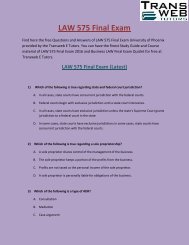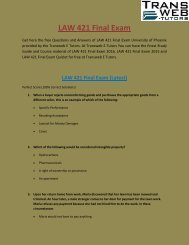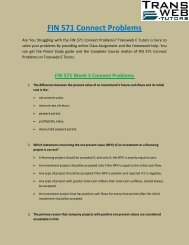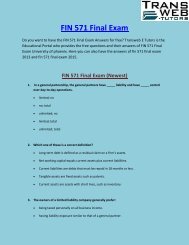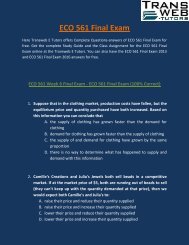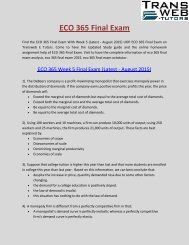ECO 372 Final Exam : ECO 372 Final Exam Answers Free | Transweb E Tutors
Transweb E Tutors is providing the Free Answers of ECO 372 Final Exam for the students of University of Phoenix. At Transweb E Tutors you can also have the Study guide of ECO 372 Final Exam, ECO 372 Week 5 Final Exam Answers, ECO 372 Final Exam 2014 Answers and current news about the ECO 372 Final Exam Student of Fortune 2016 Exam. http://www.transwebetutors.com/university-of-phoenix/ECO-372.html
Transweb E Tutors is providing the Free Answers of ECO 372 Final Exam for the students of University of Phoenix. At Transweb E Tutors you can also have the Study guide of ECO 372 Final Exam, ECO 372 Week 5 Final Exam Answers, ECO 372 Final Exam 2014 Answers and current news about the ECO 372 Final Exam Student of Fortune 2016 Exam.
http://www.transwebetutors.com/university-of-phoenix/ECO-372.html
Create successful ePaper yourself
Turn your PDF publications into a flip-book with our unique Google optimized e-Paper software.
<strong>ECO</strong> <strong>372</strong> <strong>Final</strong> <strong>Exam</strong><br />
<strong>Transweb</strong> E <strong>Tutors</strong> is the best supplier of course material of <strong>ECO</strong> <strong>372</strong> <strong>Final</strong> <strong>Exam</strong> of<br />
University of Phoenix. Find the 100 % correct answers of <strong>ECO</strong> <strong>372</strong> Week 5 <strong>Final</strong><br />
<strong>Exam</strong>. Get the latest updated study guide of UOP <strong>ECO</strong> <strong>372</strong> <strong>Final</strong> <strong>Exam</strong> and the<br />
news about <strong>ECO</strong> <strong>372</strong> <strong>Final</strong> <strong>Exam</strong> student of fortune test.<br />
<strong>ECO</strong> <strong>372</strong> Week 5 <strong>Final</strong> <strong>Exam</strong> (Latest - 100% Correct)<br />
1. News Story: Workers at a car-manufacturing plant in Flint, Michigan are laid off because the<br />
economy is weak and GM cars aren't selling well. GM isn't sure when the plant will reopen.<br />
What type of unemployment describes the workers' situation?<br />
<br />
<br />
<br />
<br />
Frictional unemployment<br />
Structural unemployment<br />
Full unemployment<br />
Cyclical unemployment<br />
2. Globalization that allows governments to pursue expansionary policies can be dangerous<br />
because it can lead to:<br />
<br />
<br />
<br />
<br />
A reduction in the debt ceiling<br />
Goods price inflation<br />
Asset price inflation<br />
Goods price deflation<br />
3. Macroeconomics is:<br />
<br />
The study of aggregate economic relationships.
An analysis of economic reality that proceeds from the parts to the whole.<br />
The study of pricing policies of firms and the purchasing decisions of households.<br />
The study of individual choice and how that choice is influenced by economic forces.<br />
4. Which of the following types of unemployment is considered to be the most controllable<br />
through demand-side macroeconomic policy?<br />
<br />
<br />
<br />
<br />
Frictional unemployment<br />
Cyclical unemployment<br />
Structural unemployment<br />
Natural unemployment<br />
5. If banks hold excess reserves whereas before they did not, the money multiplier:<br />
<br />
<br />
<br />
<br />
Will become smaller<br />
Will become larger<br />
Might increase or might decrease<br />
Will be unaffected<br />
6. Using the expenditure approach, gross domestic product equals:<br />
<br />
<br />
<br />
<br />
The sum of consumption, investment, government purchases, and net exports<br />
Gross national product minus net exports<br />
The sum of consumption, investment, and government purchases<br />
Gross national product<br />
7. How do investment in technology and investment in capital differ?<br />
<br />
They have similar effects on output so they have no important differences from an<br />
economic point of view.
They have the same effects on output but investments in technology are much more closely<br />
tied to the level of saving than investments in capital.<br />
They have different effects on output because of the positive externalities associated with<br />
investments in capital.<br />
They have different effects on output because of the positive externalities associate with<br />
investments in technology.<br />
8. The interest rate is the price paid for use of a:<br />
<br />
<br />
<br />
<br />
Real asset.<br />
Financial liability.<br />
Financial asset.<br />
Real liability.<br />
9. If the reserve requirement is 20 percent, and banks keep no excess reserves, an increase in an<br />
initial inflow of $100 into the banking system will cause an increase in the money supply of:<br />
$50<br />
$100<br />
$500<br />
$20<br />
10. Suppose farmers can use their land to grown either wheat or corn. The law of supply predicts<br />
that an increase in the market price of wheat will cause:<br />
<br />
<br />
<br />
<br />
Farmers to substitute wheat for the production of corn.<br />
Farmers to raise the production of corn and wheat.<br />
Farmers to lower the production of corn and wheat.<br />
Farmers to substitute corn for the production of wheat.
11. According to Keynes, why might deflation create problems for an economy?<br />
<br />
<br />
<br />
<br />
In expectation of increased spending, too many entrepreneurs would begin businesses and<br />
most would fail.<br />
The cost of repricing goods would increase costs, and therefore reduce profits, for<br />
businesses and they would cut production.<br />
People would drop out of unions because unions would become ineffective at keeping<br />
wages of members high.<br />
Consumers might expect prices to fall further and cut back consumption now.<br />
12. When interest rates rise, people are:<br />
<br />
<br />
<br />
<br />
More likely to borrow, that is, purchase a financial asset.<br />
More likely to borrow, that is, sell a financial asset.<br />
Less likely to borrow, that is, sell a financial asset.<br />
Less likely to borrow, that is, purchase a financial asset.<br />
13. According to the Classical growth model, an economy that increases its saving will grow:<br />
<br />
<br />
<br />
<br />
Quickly since the increase in saving will permit greater investment.<br />
Quickly since the increase in saving will permit more rapid technological progress.<br />
Slowly because interest rates will fall, causing investment to decline.<br />
Slowly because consumption and aggregate demand will be reduced.<br />
14. Suppose that consumer spending is expected to decrease in the near future. If output is at<br />
potential output, which of the following policies is most appropriate according to the AS/AD<br />
model?<br />
<br />
<br />
<br />
A reduction in government spending<br />
An increase in taxes<br />
An increase in government spending
No change in taxes or government spending<br />
15. Which of the following topics is best characterized as a macroeconomic issue?<br />
<br />
<br />
<br />
<br />
The effect of a drought on the price of corn<br />
The decision by Apple to produce fewer Macintosh computers<br />
The effect of an increase in federal spending on the unemployment rate<br />
The choice a student makes in selecting college course<br />
16. If income increases more rapidly than expected, then:<br />
<br />
<br />
<br />
<br />
Estimates of the target rate of employment are likely to increase.<br />
The budget is less likely to be in surplus.<br />
Tax revenues will be lower than expected.<br />
Spending on income-support programs will likely be lower than expected.<br />
17. In which of the following situations is a budget surplus most likely to occur?<br />
<br />
<br />
<br />
<br />
When fiscal policy is contractionary and the economy is expanding<br />
When fiscal policy is expansionary and the economy is contracting<br />
When fiscal policy is expansionary<br />
When the economy is contracting<br />
18. The largest expenditure component of GDP is:<br />
<br />
<br />
<br />
<br />
Government spending<br />
Net exports<br />
Investment<br />
Consumption
19. Which of the following is the path through which contractionary monetary policy works?<br />
<br />
<br />
<br />
<br />
Money down implies interest rate up implies investment up implies income down.<br />
Money down implies interest rate down implies investment down implies income down.<br />
Money down implies interest rate up implies investment down implies income down.<br />
Money down implies interest rate down implies investment up implies income down.<br />
20. As a country develops economically, what changes usually take place in the goods it exports?<br />
<br />
<br />
<br />
<br />
There is little change because comparative advantage does not change.<br />
Exports go from being diversified to being specialized in whatever the country finds to its<br />
comparative advantage.<br />
Services and manufactured goods decline in importance and are replaced by raw materials<br />
and agricultural products.<br />
Raw materials and agricultural products decline in importance and are replaced by services<br />
and manufactured goods.<br />
21. What would make foreigners want to buy more from the United States?<br />
<br />
<br />
<br />
<br />
Higher tariffs<br />
Higher interest rates in the United States<br />
Inflation in the United States<br />
A fall in the value of the dollar in the foreign exchange market<br />
22. The depreciation of currency will:<br />
<br />
<br />
<br />
<br />
Balance a trade surplus.<br />
Have no impact on a country's comparative advantage.<br />
Worsen a country's comparative advantage.<br />
Improve a country's comparative advantage.
23. The government of Crossland wants to influence its exchange rate. It will do so by buying and<br />
selling:<br />
<br />
<br />
<br />
<br />
Currencies in its official reserves<br />
Commodities<br />
Goods and services from the current account<br />
Transfers<br />
24. If a country wants to prevent its exchange rates from falling, it could:<br />
<br />
<br />
<br />
<br />
Place restrictions on imports<br />
Pursue easier monetary policy<br />
Remove any subsidies on exports<br />
Remove restrictions on imports<br />
25. Central banks are responsible for:<br />
<br />
<br />
<br />
<br />
Both monetary policy and fiscal policy<br />
Monetary policy but not fiscal policy<br />
Neither monetary policy nor fiscal policy<br />
Fiscal policy but not monetary policy<br />
26. Quotas and tariffs can:<br />
<br />
<br />
<br />
<br />
Never have the same effect on imports and import prices.<br />
Have the same effect on the price of domestically produced goods if they are set<br />
appropriately.<br />
Yield the same amount of tax revenue if they are set appropriately.<br />
Both increase international trade by the same amount if set appropriately.
27. Between 2007 and 2009, the U.S. unemployment rate rose from under 5 percent to over 8<br />
percent. A Keynesian economist would most likely blame this increase in unemployment on:<br />
<br />
<br />
<br />
<br />
An increase in the minimum wage.<br />
An increase in the bargaining power of labor unions.<br />
A decline in the level of aggregate demand.<br />
A decline in aggregate supply.<br />
28. U.S. imports involve an:<br />
<br />
<br />
<br />
<br />
Inflow of foreign currency from foreigners to the U.S. economy<br />
Inflow of dollars from foreigners to the United States economy<br />
Outflow of foreign currency from the United States to foreigners<br />
Outflow of dollars from the United States to foreigners<br />
29. The law of demand states that quantity demanded of a good is inversely related to the price of<br />
that good. Therefore, as the price of a good goes:<br />
<br />
<br />
<br />
<br />
Up, the quantity demanded goes down.<br />
Down, the quantity demanded stays the same.<br />
Up, the quantity demanded also goes up.<br />
Down, the quantity demanded goes down.<br />
30. According to Keynes, market economies:<br />
<br />
<br />
<br />
<br />
Never experience significant declines in aggregate demand.<br />
Are constantly experiencing significant declines in aggregate demand.<br />
May recover slowly after they experience a significant decline in aggregate demand.<br />
Quickly recover after they experience a significant decline in aggregate demand.
Other available courses at <strong>Transweb</strong> E Tutor which are similar to the <strong>ECO</strong> <strong>372</strong> <strong>Final</strong><br />
<strong>Exam</strong> is listed below:<br />
<strong>ECO</strong> <strong>372</strong> <strong>Final</strong> <strong>Exam</strong><br />
<strong>ECO</strong> 561 <strong>Final</strong> <strong>Exam</strong><br />
FIN 370 <strong>Final</strong> <strong>Exam</strong><br />
FIN 571 <strong>Final</strong> <strong>Exam</strong><br />
FIN 571 Connect Problems<br />
FIN 575 <strong>Final</strong> <strong>Exam</strong><br />
LAW 421 <strong>Final</strong> <strong>Exam</strong><br />
To find more visit:<br />
http://www.transwebetutors.com/









